Arunji, whose anecdotes and memories of the good old times we adore and whose filmi knowledge, we admire, springs in the arena once again to fill up the empty time space here. Thank you Arunji! Without much ado, I pass the mike to him.
Arunkumar Deshmukh’s ten favourite inspired song-pairs
EK DIL DO JAANE- EK TUNE DO GAANE
The other day I was reading a book in my Drawing Room,when I heard my college going grandson telling a small boy,” you don’t know,but in our times,things were not like this…”
I smiled. Every generation thinks that their times were better that the present one.
I wondered whether if I tell today’s children that in my college days,Petrol was costing only 5 Rupees a Gallon (around 3.7 Litres) or that a car driver could be hired on a salary of Rs.150 pm, will they believe it ? We never believed when our elders told us that Gold was bought by them at 10 Rs. a Tola (about 11.4 Gms.),because at the time of my marriage Gold was costing 150 rupees per Tola(about 11.4 gms).Today when Gold has crossed the barrier of rs.30000 for just 10 gms,these stories look like Arabian Night stories,indeed !!
Sometimes I keep thinking if old times were better or the present times are better.I have not been able to come to any conclusion so far.

I spent my childhood and college days in Hyderabad-a state ruled by a Muslim King,The Nizam,who ruled over 85% Hindu population-in sharp contrast to the Hindu King Hari Singh of Kashmir who ruled over 85% Muslim population.The official language was Urdu,but Education was available in many languages to choose from.There was no force.Knowledge of Urdu had a distinct advantage,but English was an added qualification.
Compared to today everything was cheap and in plenty.Accordingly the salaries were also modest. A lower division clerk in Govt.Service was getting 75 to 100 rupees salary,but then a 2 room house was available on a rent of 10 rupees only.Milk was just 4 annas a litre( 16 annas made 1 Rupee). Nizam state had its own currency which was called ‘ HAALI ‘ Rupiya. The British Rupee was also accepted here at a cost of about 1.6 Haali Rupiah. The British Rupee was called ‘ KALDAAR ‘. A month’s 2 times meals in a good Veg Hotel were available for only 30 Rupees in those days,with a ‘feast’ of sweets on every Sunday !.
The cost of Entertainment was also cheap. A 78 RPM record was costing only 10 annas and a gramophone was costing from 50 to 100 rupees.
Life was very easy and crisis free. My school fees till 10th,in a renowned private school was only 1 rupee 8 Annas pm. Private tuitions were unheard of and were considered an insult.Only the other day my daughter told me that they have paid 1.5 lakh rupees as fees for the Tutorial Classes for the 12th std -that too 6 months in advance !
There was less competetion,less struggle for existance and people still believed in honesty,respect for elders and hard work.
All this showed up in the Film world also.
When Ashok Kumar was put up as a Hero in Bombay Talkies,his salary was just 100 rupees.When his 3 consecutive films were Hits,his salary was increased to Rs.250. Saadat Hasan Manto writes in his book,”Another stars in the sky”, that Ashok kumar was afraid that somebody will steal his money and hence kept all his money under his pillow always.Manto took him to a Bank to open an account !
In the initial stages,Lata used to get only Rs.50 per song.According to her,she increased it slowly to 500 in the 50s and 5000 in the 60s.I do not know how much she charges nowdays,may be 50000 to 1 lakh,may be.
Music Directors and singers were proud of their art and were ready to do any hard work.Composers like Naushad insisted on several rehersals before recording and every singer complied without any grumble.
Composers were helpful to each others without having a cut throat competetion.Snatching films from other composers started in the 60s (foremost was OPN).bargains on payments were made.And slowly,quietly and very casually composers started getting ‘ inspired ‘ by each other’s popular songs.In the period 8os and beyond,plagiarism was no more a bad word,it was changed to a Royal ‘ Lateral Inspiration ‘,because for many songs the source used to be the same western song !
Not that these things did not happen in earlier times,but few cases where same-tune songs were found they were atleast not intentional.later on many ,nay,almost all well known composers did it.
Bengali composers like Hemant da,Sachin da,Salil da and Anil da borrowed popular old,private Bangla songs and folk songs of the east,C.Ramchandra copied Marathi natya and Bhav geets and the rest looked here and there and beyond 7 seas for ‘ inspiration ‘.
Originality was the victim in the crowded Music scene in Bollywood.
During my work on old Films and Music of Hindi films,I came across many songs which had an uncanny resemblance to some old or contemporary songs.I have collected such 10 songs,wherein you will find the mukhda,or the Antara or the entire song is similar to some other song.
I dare not call it a ‘theft’,but it is hardly a case of Telepathy either ! call it what you want, but here are the 10 double gems. Just enjoy and wonder…….
1. The first song is:
Main jab bhi akeli hoti hoon – Dharamputra [1961]
MD: N.Datta; Lyricist: Sahir Ludhianvi; Singer: Asha Bhosle
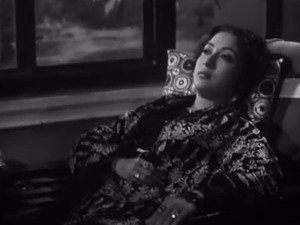
Now note the uncanny resemblance to this song:
Naadan muhabbat walon ke – Jaadoo [1951]
MD: Naushad, Lyricist : Shakeel Badayuni and the singer is: Lata Mangeshkar

2. This song was very popular once:
De di hamen Azaadi – Jagriti [1954]
MD: Hemant Kumar,Lyricist: Kavi Pradeep; Singer: Asha Bhosle and chorus.
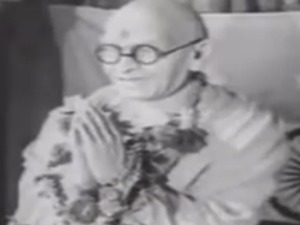
Just hear the original tune:
Kya mil gaya Bhagwan – Anmol Ghadi [1946]
MD: Naushad,Lyricist: Anjum Pilibhiti and the singer is Noor e Tarannum, Noor jehan.
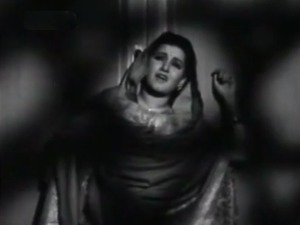
In one of the interviews given to Subhashchandra Jadhav for ‘Voh bhooli Dastaan’, Kavi Pradeep had said that he was in the habit of giving Lyrics to the composer with a suggested tune based on some old songs.Many of his songs are like that.When he gave the above tune to Hemant Kumar,he was so furious that he vowed never to work with Pradeep ji again.
3. Here is a less known song from a well known film:
Dil leke daga denge – Naya Daur [1957]
MD: O P Nayyar,Lyricist: Sahir Ludhiyanvi and the singer is Mohd.Rafi
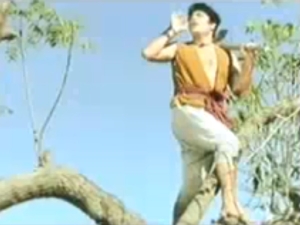
The ‘inspiration’ came from:
Aa jao tumhe dil ka – Heer [1956]
MD: Anil BIswas,Lyricist: Majrooh Sultanpuri and the singers are Asha and Rafi
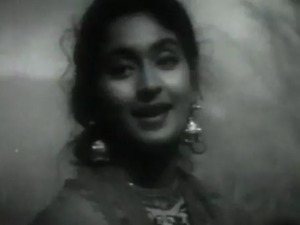
4. here is a song from Dharmendra-Rakhee starrer:
Zamane mein aji kai aise naadan – Jeevan Mrityu [1970]
MD: Laxmikant Pyarelal,Lyricist: Anand Bakshi and the singer is: Lata
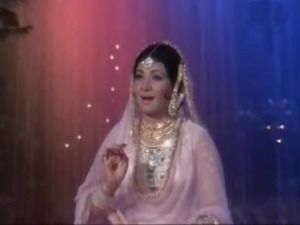
one of the early songs of the 40s was the source:
Dil e naashaad ko jeene ki hasrat – Chunariya [1948]
MD: Hansraj Behl,Lyricist: B R Sharma and the same singer: Lata
5. A Mid 60s popular song:
Aye phoolon ki raanee – Arzoo [1965]
MD: Shanker-Jaikishen, Lyricist: Hasrat Jaipuri and the singer: Rafi
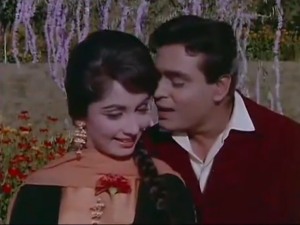
If you hear this song now, you may feel the similarity:
Hamee se muhabbat hamee se Ladai – Leader [1964]
MD: Naushad, Lyrics: Shakeel Badayuni and the singer is same: Rafi
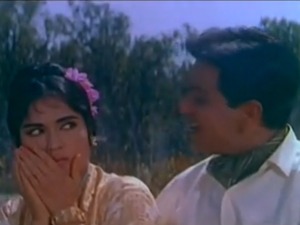
(sometimes I wonder, in such cases of similarity,what must be the singer thinking ? )
6. Here is a case from the 40s and the original popular song is:
Dil jalta hai to jalne de – Pehli Nazar [1945]
MD: Anil Biswas, Lyrics: Dr.Safdar ‘Aah’ and the famous singer was : Mukesh
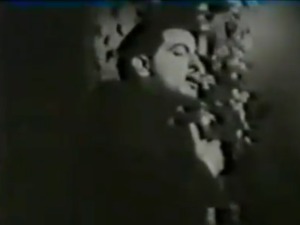
The following song has taken ‘inspiration from the above Mukesh song:
Kiska deep Jalta hai – Didi [1948]
MD: Mukund Masurekar, Lyricist: Saraswati Kumar Deepak and the singer is: Shanker Das Gupta
7. In this song, the begining itself is inspirational!
Yeh parda hataa do – Ek Phool Do Maali [1969]
MD: Ravi, Lyricist: Prem Dhawan and singer: Asha/Rafi
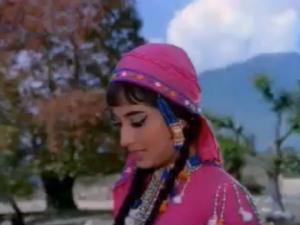
Now listen to this song and you will know the source:
Vo chaand muskuraya – Aakhri Dao [1958]
MD: Madan Mohan,Lyricist: Majrooh Sultanpuri,singer: Lata / Manna Dey
8. A song from the 60s:
Rahen na rahen hum – Mamta [1966]
MD: Roshan,Lyricist: Majrooh Sultanpuri,Singer: Lata
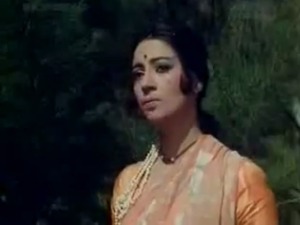
The inspirational famous tune is:
Thandi hawayen – Naujawan [1951]
MD: S D Burman,Lyrics: Sahir Ludhiyanvi and the same singer: Lata
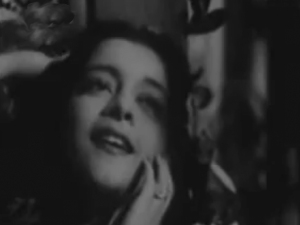
9. Wonder pe thunder ! Same film songs: Auto Inspiration!
Aap se maine meri jaan – Yeh Raat Phir Na Aayegi [1966]
MD: O P Nayyar,Lyricist: S H Bihari, singers: Asha / Rafi
 now a song from the same team:
now a song from the same team:
Phir miloge kabhi – Yeh Raat Phir Na Aayegi [1966]
MD: O P Nayyar,Lyricist: S H Bihari, singers: Asha / Rafi
10. The final song from a hit film of the early 60s:
Aankhon se jo utari hai dil mein – Phir Wohi Dil Laya Hoon [1963]
MD: O P Nayyar,Lyricist: Majrooh Sultanpuri,Singer: Asha

Here is the original tune:
Poocho na hamein – Mitti Me Sona [1960]
MD: O P Nayyar, Lyricist: Raja Mehdi Ali Khan, singer: Asha
Not that ALL tunes are 100% same but they do remind the other songs strongly in Mukhada, Antara or the entire tune !
harveypam
March 20, 2013 at 7:15 am
Thank you Arunji for this wonderful post. The songs are a real revealation!
I enjoyed going on this journey of discovery.
The tune of naadan mohabbatwaalon ke seems to have been itself inspired by wo paas rahe ya door rahe from Badi Behen. Don’t you think so?
The relationship between thandi hawayein lehrake gaaye (Naujawan) and rahe na rahe ham (Mamta) is a bit more complicated. Roshan it seems let himself be inspired only 4 years later for tera dil kahan hai (Chandni Chowk 1954)
featuring Seema Biswas
Ten years later Madan Mohan came up with somewhat similar tune for yeh hi hai tamanna for Aap ki Parchhaiyan (1964)
21 years later the beta of the original tune maker then landed up with a big hit with the same tune but completely other orchestration with
sagar kinare dil yeh pukare for Saagar(1985)
But he had also experimmented with this tune four years earlier in the song hame raston ki zaroorat nahin hai Naram Garam (1981)
S D Burman by the way, had supposedly also let himself be inspired for the Naujawan tune by the music from Algiers (1938)]. I couldn’t find any evidence for that though.
Speaking of Pancham, one surely remembers his maine puchha chaand se from Abdullah (1980)
But very few people know of koi aur duniya me from Pyar Ki Kahani (1971)
which not only has the same tune but also the same singer. Even the theme is the same.
So now I will stop hogging the space here and let others comment.
pacifist
March 20, 2013 at 9:39 am
Harvey that’s an equally well researched comment. One hears the similarity so well (except in a couple of songs).
Thanks for this. 🙂
harveypam
March 20, 2013 at 9:57 am
*heart* “except in a couple of songs” *heart*
That is a really good compliment! Thanks pacifist! 🙂
dustedoff
March 21, 2013 at 8:40 am
I was going to write the same thing! Very well-researched comment, Harvey. And, Arunji: thank you for a very interesting post. I hadn’t realised there were so many songs that ‘borrowed’ the same tune from earlier Hindi films. Some of them are particularly striking in their similarity.
harveypam
March 22, 2013 at 8:47 pm
Thank you Madhu!
It wasn’t at all well-researched. I read about it in a R. D.Burman biography.
Arunkumar Deshmukh
March 25, 2013 at 8:51 am
Harvey ji,
Thanks to you for giving me this opportunity.Your other songs are good.Thanks again.
-AD
Harish
August 18, 2013 at 9:02 pm
As an experiment I have combined two songs one from Banarasi Thug (Rafi_Lata) and other from Cha cha cha (Rafi_Asha) songs together. Just see the results:http://www.youtube.com/watch?v=YBmomMvmHGo
harveypam
August 30, 2013 at 12:11 pm
well done Harish!
ASHOK M VAISHNAV
March 20, 2013 at 7:34 am
We, myself and AKji, were wondering as to how to go about collecting songs for such a subcategory, for our series “Multiple version Songs ” @ SoY.
Let me confess, I could never have gone beyond 2 or 3 songs on my own, whereas we have 10 x2 songs by Arunji and 7 songs on the very first comment.
Hats off! Such a marvelous job…….
Each of the song, barring a couple ones, are stand out renditions. So , who would have taken pains to talk about ‘uncanny similarity’?
Using one’s own tune – from one language platform to another language platform could become possible because of the uncanny ability of lyricists to come up with lyrics that not fitted the metre but also the mood of the situation.
Looking forward to more illustrations for the other readers…….
harveypam
March 20, 2013 at 10:02 am
That is a good initiative Ashokji!
You can of course skim the songs from here! 🙂
Thank you Ashokji!
Arunkumar Deshmukh
March 20, 2013 at 8:57 am
Ashok ji,
I never knew that you were on the look out for such songs. I have some more with me,which I could not accommodate here as the post would have been too long. I can pass them on,without posting them anywhere,for your benefit.
-AD
ASHOK M VAISHNAV
March 20, 2013 at 6:15 pm
Arunji,
That would just be wonderful.
As and when I would take upworking on that subject, I shall sek your collaboration on this subject.
pacifist
March 20, 2013 at 9:37 am
This is a very well researched and knowledgeable post Arunji. Some songs are so clearly ‘inspirational’ ones. Thank you so much to both you and harvey.
It’s a very challenging post for the readers to rack their brains and come up with similarities in songs. I know that sometimes when listening to a song I do realise a similarity to a tune of another song – but not easy to recollect which ones.
Tunes of two songs in Madhumati stand out in my memory as having resemblance.
aaja re pardesi at 1:10 and onwards has a piece of music…
… that is exactly the same as the tune of the song ghadi ghadi mora dil dhadke
harveypam
March 20, 2013 at 9:58 am
That is very much true, pacifist!
Love ghadi ghadi mora dil dhadke
Anu Warrier
March 20, 2013 at 3:32 pm
pacifist, Aaja re pardesi itself was inspired by Salilda’s background music from Jagte Raho. Salilda, in fact, reused many of his tunes from other languages in Hindi, and vice versa.
pacifist
March 22, 2013 at 4:23 pm
Which one, Anu? Just being lazy and asking instead of looking it up.
World of Cinema
March 20, 2013 at 3:54 pm
Oh No! As I was reading Mr.Deshmukh’s post, I was happily thinking of posting these two songs, after all this was often discussed at home but (sigh) I was beaten to the draw by pacifist, well kya karoon, kuch aur sochna padega.—- Shilp
pacifist
March 22, 2013 at 4:20 pm
😀
ASHOK M VAISHNAV
March 21, 2013 at 5:04 am
Here is an equally famous example of blending of a tune of a song in the music of an antara of another song, by Salil Chaudhary
Saathi re, Tujh Bin Jiya Udaas – Poonam Ki Raat – http://youtu.be/2E-JFRdWeLo – listen to the music of the antara @ 2.07 and you will find Mukhda of Baag Men Kali Khili – Chand Aur Suraj – http://youtu.be/9XKko4591bk
ASHOK M VAISHNAV
March 21, 2013 at 5:24 am
Here is more on Bagh Men Kali Khili form an encyclopaedic site on Salil Chaudhary – salilda.com :
“‘Baagh mei.n kali khili’ is an amazing song and the film version is much longer and much better than the meagre three minute version HMV released years back. Salil was clearly quite impressed with his own composition. He used the melody of this song in many other songs and background music. In an interview he did mention that one of his favourite compositions is ‘Baagh mei.n’.”
And links to its Malayalam version – http://salilda.com/filmsongs/malayalam/chemmeen.asp (use code CM2) – notes on that song – “Song#CM2 is really a mixture of two songs ingeniously merged together ! It starts with the melody of “shuno shuno go sabey” (Kishore in bengali film “Kobita”) followed by the antara in the melody of “jaa re jaa aamaar aashaar” by Sabita which is the bengali version of “baag mei.n kali khili”. After the antara Salil used the interlude music from “jaa re jaa” to great effect. Quite impressive really. Its interesting to see that the Chemmeen song and Sabita’s “jaa re jaa” were recorded in 1965 where as “Kobita” was made in 1977. So one starts wondering about the origin of the melody in “shuno shuno go sabey”.
Song#CM3 also has some interlude music from “baag mei.n kali khili” ! Looks like Salil just couldn’t get rid of that tune from his head !”
And the icing on the cake is the Bengali version – http://www.salilda.com/songs/nonfilm/bengali/adhunik/sabita/jaarejaa.mp3 (Use Code SC8).
Salilda’s genius can be seen in how creatively he has deployed his inspiration.
harveypam
March 22, 2013 at 7:33 pm
That is a mine of information! Wow!
Thank you Ashok!
The link salilda.com sounds interesting! Thanks for that link too.
Arunkumar Deshmukh
March 25, 2013 at 8:53 am
Thanks Pacifist ji.
harveypam
March 20, 2013 at 9:59 am
Arunji won’t be able to answer the comments till Sunday, because had to depart on a trip out of town. He will write as soon as he is in his home town again on Sunday.
Thank you!
chitrapatsangeet
March 20, 2013 at 12:41 pm
One of the obviously inspired gems was “Tujhe Kya Sunaaoon mein dilruba”, which was a copy and paste from Sajjad’s “Yeh hawa yeh raat ye chaandni”.Sajjad gave a piece of his mind to Madan Mohan, Not just the tunes were similar, Rajinder Krishen wrote lyrics for both of them. 🙂
harveypam
March 22, 2013 at 7:37 pm
I had completely forgotten about this!
Nice to see Shammi there.
Arunkumar Deshmukh
March 25, 2013 at 8:54 am
I did not select it as it was too well known ‘inspiration’.
chitrapatsangeet
March 20, 2013 at 12:45 pm
See how obvious this one is 🙂
chitrapatsangeet
March 20, 2013 at 12:48 pm
Sorry, at 6:05, there is a lovely instrumental piece, which later translated into 2 songs-one by Lata and one by Rafi.
harveypam
March 22, 2013 at 7:40 pm
Wow!
You have a great memory, Karthik!
raja
March 20, 2013 at 3:35 pm
Very nice post, Arunji. Not just the songs bit but also the trip down memory lane. I was just thinking maybe you should have bought oil and gold with every paisa you had at that time. 🙂
An example of similar tune / inspired is :
Mere dilbar mujh par khafa na ho – Dharmaputra
Ye jo halka halka suroor hai – Souten Ki Beti
(Actually these lyrics are best-known thanks to Nusrat Fateh Ali Khan and his concerts).
Then there is:
Mere mehboob shaayad aaj – Chandrani Mukherjee – Kitne Paas Kitne Door (1976)
I used to hear this song a lot when I was in high school (it was fairly popular) and I always felt it reminded me of another song.
I leave it to readers here to tell me which song or songs this could be. 🙂
harveypam
March 22, 2013 at 7:45 pm
Amazing that similarity between the songs of Souten ki Beti and Dharamputra. I should admit, that I didn’t know both of them.
As for the other song, I’m completely clueless, but Pacfist will come up with something for sure.
pacifist
March 22, 2013 at 10:00 pm
I did, harvey. Here it is;
Arunkumar Deshmukh
March 25, 2013 at 8:56 am
Thanks Raja ji.
Anu Warrier
March 20, 2013 at 3:45 pm
Great post, Arunji. It takes some time to remember the ‘inspirations’. Off the top of my head:
The inspiration for Bagh mein kali khili
was the original Malalayam tune from Chemmen – the song was this one:
Similarly, a part of Shankar-Jaikishen’s background score for Awara eventually became O basanti pavan paagal from Jis desh mein Ganga behti hai.
The original: Aaj Mausam Ki Masti Mein Gaaye Pawan from Benarasi Thug
The inspiration: Ek Chameli ke mandve tale from Cha Cha Cha
The original: Kya Kya Na Sitam Tujh Pe Huve Mehlon Ki Rani (Mohini 1957)
The inspiration: Tu hindu banega na mussalman banega (Dhool ka phool 1959) N Dutta
Now if someone will write a guest post so my blog is not completely abandoned? 😦
World of Cinema
March 20, 2013 at 4:03 pm
Anu Baagh mein kali khilli and the Chemeen song are the same because the music directors are the same, I guess you know that, that is what most of the Bengali music directors did— Shilpi
World of Cinema
March 20, 2013 at 6:01 pm
I was rushing that should read – the music director is the same (and not music directors are the same) for both films, Salil Choudhury— Shilpi
PARTHA CHANDA
July 8, 2015 at 4:07 am
To put things in correct perspective , in chronological order : First was the Bengali Song by Sabita Chowdhury in early 1965 , then came “Bagh Mein Kali Khili” in Hindi in late 1965 and finally that song from “Chemmeen” in mid-1966 .
harveypam
July 8, 2015 at 2:20 pm
Thanks for putting it in a chronological order, Parthaji! It helps very much to percieve things. Thanks you! 🙂
pacifist
March 22, 2013 at 5:06 pm
Anu, you’re going to write Van Shiplay part 2!! 🙂
harveypam
March 22, 2013 at 8:23 pm
I knew Salil Choudhary recycled most of his tunes and also knew about Chemmen. But the other songs were all new for me.
Of course I know ek chameli ke mandve tale, but didn’t know that it was recycled as that Poonam Ki Raat song.
And where did you get that Mohini song? Nice to see Nirupa Roy playing a martyr for a change.
Amazing!
thanks for introducing me to these new songs.
Arunkumar Deshmukh
March 25, 2013 at 8:56 am
Thanks,Anu ji.
World of Cinema
March 20, 2013 at 4:26 pm
Continuing from what I have written in reply to Anu’s post, Bengali music directors usually used their own compositions in Hindi films. They used to compose tunes for what used to be called private songs- that is non-film songs- during the Durga Puja festival and later they borrowed these tunes in Hindi films and yes of course it was not always non-film songs, it could be a film song too. There are number of examples in fact I could do a whole post on it. For the moment here are a few example
Lata’s Bekaraar Dil composed by Hemant Kumar
And now listen to Hemant Kumar’s rendition of his own composition. This is a private song—Shilpi
PARTHA CHANDA
July 6, 2015 at 1:39 am
This is not a Private Song . It is from the 1959 Bengali Movie “NEEL AKASHER NEECHEY” , a story about a Chinese Traveller to India . See the following link
harveypam
July 7, 2015 at 6:51 pm
That is a nice song, Partha Chandaji and also thanks for the information.
World of Cinema
March 20, 2013 at 4:29 pm
Continuing from above, likewise listen to R.D.Burman’s Bengali original of Shaam mastani, once again a private Bengali song- Shilpi
harveypam
March 22, 2013 at 8:27 pm
That is true Shilpi. The puja songs phenomenon with Bengali music directors is indeed common. I think alone R D Burman’s list would run into hundreds. Thanks for these beautiful examples.
Arunkumar Deshmukh
March 25, 2013 at 8:58 am
Bangla to Hindi are many many songs.But this post was about Hindi to Hindi so i restricted myself to it only. Thanks.
World of Cinema
March 20, 2013 at 4:40 pm
Would have liked to have posted some more songs but running out of time, will come back later— Shilpi
ASHOK M VAISHNAV
March 20, 2013 at 6:38 pm
We are collaborating @ SoY for collating such songs from other languages to and from Hindi Film Songs under Multiple Version Songs. You might have observed that Shri Arunji has done an article for Marathi and Shri N Venkataramana has done one for Tamil, and he has lined up others to follow. I would be doing a piece on Gujarati.
May suggest that you may prepare a whole article(s) separately for each of Bengali Music directors – SDB, Salil Chaudhary, Hemant Kumar, R D Burman etc. and post them to AKji.
thandapani
March 20, 2013 at 5:12 pm
Lovely post Arunji. Of course the famous example is that of Madan Mohan stealing the tune of this lovely song = “Tujhe kya sunao me dilruba” from “Yeh hawa ye raten ye chandani”
I guess nothing can be achieved without ‘inspiration’.
As they say originality is merely undetected plagiarism.
harveypam
March 22, 2013 at 8:30 pm
Love the line “As they say originality is merely undetected plagiarism.”
Arunkumar Deshmukh
March 25, 2013 at 9:02 am
Thanks,Ava ji.
I believe ‘Inspiration ‘ should evoke originality and not just repetetion,with slight ‘here and there’.
-AD
Chris
March 20, 2013 at 5:38 pm
Very interesting topic for the post.
This might be the song which inspired ‘Thandi hawayein’
Here is another example of one song inspiring 2 or more:
1.from Footpath 1953, music Khayyam
2.from Parakh 1960 music Salil Chaudhary
3.from Naina 1973 music Shankar Jaikishan
4.from Yes Boss 199 music Jatin Lalit
harveypam
March 22, 2013 at 8:36 pm
Wow, what a sharp observation, Chris!
A tune spanning 5 decades under four different music directors!
Really amazing!
harveypam
March 22, 2013 at 8:41 pm
I listened to that Algiers song before, but it just doesn’t fit thandi hawayein tune!
Chris
March 20, 2013 at 7:22 pm
Does this song sound like ‘Yahi hai tamanna, tere ghar ke saamne’? If yes, then another version of ‘Thandi Hawayein”?
harveypam
March 22, 2013 at 8:38 pm
Now that yo point out, it does sound like yahi hai tamanna! Never thought of it before.
coolone160
March 21, 2013 at 4:59 pm
Three of my favorite songs #3, #5, #7 are “inspired”.Never thought of it before! Very sharp observation indeed.
🙂
coolone160
March 21, 2013 at 8:36 pm
Reblogged this on coolone160 and commented:
must read…………………
harveypam
March 22, 2013 at 8:40 pm
That is very nice of you coolone!
coolone160
March 23, 2013 at 5:19 am
🙂
pacifist
March 22, 2013 at 5:13 pm
Sharp observation Chris. But I’ve failed to see any similarity of the English song with Thandi hawaayein
Shalini
March 23, 2013 at 3:41 am
I don’t agree that a music director reusing a tune he/she had previously composed constitutes “copying” or “inspiration.” I mean surely one has the right to reuse one’s own creation as often as one likes!
That said, it’s fun to find “reccurrent” tunes by an MD. Here’s a pair by Madan Mohan that I’m particularly fond of:
Aankhon aankhon mein hogaye mast ishaare (Khazanchi)
Nainonwaali ne hai mera dil loota (Mera Saya)
Now for an example of Madan Mohan truly being “inspired” by another MD 🙂
Chup chup ke dil ki dhadkanon mein (Mohini; N. Dutta, 1957)
Kadam behke behke (Bank Manager; Madan Mohan; 1959)
Prakshchandra
March 23, 2013 at 6:48 pm
Prakshchandra
March 24, 2013 at 11:09 am
Prakshchandra
March 24, 2013 at 11:10 am
harveypam
April 3, 2013 at 8:10 pm
What a resemblance! This is one to one pick up of the original tune! Thanks Prakashji!
sorry for not replying earlier. I was out of town!
Prakshchandra
March 24, 2013 at 11:11 am
I tried many a times from yesterday to post above two videos at a shot, But I am not successful, today when i transferred 2 videos seperately, I am successful ???
harveypam
April 3, 2013 at 8:11 pm
wordpress seemed to have forgotten you Prakashji,t hough I didn’t. It sent your comments directly to the spam. i returned just yesterday, thus I could save the comments only today. Sorry for that.
bluefire
March 26, 2013 at 6:15 am
Lehra Ke Aaya Hai Jhoka (http://www.youtube.com/watch?v=lo51YFpWxAY) – Waris (1969)
babli badmaash hai (http://www.youtube.com/watch?v=4NFrmvfoFsI) – Shootout At Wadala (2013)
chitrapatsangeet
March 29, 2013 at 10:05 am
OK, this one is a bit different-
A thumri in Pahadi by Chaurasia-(start listening at 1:18)
and notice how this has completely lifted in this song in Karnan, rendered effortlessly by Susheela
harveypam
April 3, 2013 at 7:09 pm
This tune makes a huge leap from north to the south,doesn’t it? Astounding!
Canasya
April 8, 2013 at 3:33 pm
Discovered this and AKji’s blog serendipitously and have not left the PC now for hours. Every para opens door to treasures of goldies transporting one to a magical land where melody is queen, rhythm the king, yodelers and crooners are serenading divas and nightingales, and music directors are the wizards wielding baton in place of wand. When I was first introduced to the joys of Hindi film music half a century ago I thought this idyllic world was flawless, but soon I began noticing blemishes. As a fan of SDB I lapped up everything related to him — records, cassetts, CDs, books, and articles. Then I read Raju Bhartan describing how RDB and Jayadev were once taking a stroll when they heard an English song that sounded like “Thandi Hawaen”. Later RDB confronted his father who shrugged it off with something like “chalta hai”. I was skeptical. How could “Thandi Hawaen” be “English”? Raju Bhartan must be the villain! Later I read about sources for songs from “Chalti Ka Naam Gaadi”, “Munimji”, “Taxi Driver”, “Jewel Thief”, and “Sagina”. But, as a fan, I had erected defenses. I read but never listened to those sources and could truthfully say that I had not heard the similarity. And I had counter argument for every criticism. For instance, Kishore Kumar once wrote in “Outlook” implying that he regretted having asked SDB to use two foreign tunes in “Chalti Ka Naam Gaadi”. That made Kishore Kumar the culprit, not SDB!
Today I clicked on “C’est la vie”. I saw some similarity with “Thandi Hawaen”, but it was not blatant. I felt bold enough to listen to the sources of songs from “Chalti Ka Naam Gaadi”, “Munimji”, “Taxi Driver”, “Jewel Thief”, and “Sagina”. Every click turned out to be a body blow. The true villains are probably the wizards themselves. Everybody has a dark side and so did SDB. Perhaps it was commercial pressure, or an error of judgment. How much such extenuating circumstances absolve the wizards of the responsibility depends on how big a halo you have created around them. The moral for fans is – enjoy the music, but reserve your loyalty. If you put your wizards on a pedestal, be ready for disappointments.
I realize that the objective of blogs like this is, as AKji puts it, “swantah sukhay”, rather than speculation about causes for plagiarism. My knowledge of hindi music is not as extensive as that of fellow bloggers on these pages. Nor am I such a knowledgeable listener as to spot the similarity between two songs on my own, although I can appreciate the likeness once pointed out by others. I will, therefore, limit my comments to a few examples that I remember having read about decades ago and which do not appear on these pages. For instance, when “Mera Naam Joker” (1970) was released, Girija Rajendran had trashed its score in her column in “Madhuri” under the title “Joker ka sangeet idhar udhar se”. According to her, the title song “Kehta hai joker saara zamana” (https://www.youtube.com/watch?v=DeRDKvfDenk) was based on Roshan’s “Apni nazar se unki nazar tak” (Hamlog; 1951) (https://www.youtube.com/watch?v=uRQaMV5qNvs).
“Jaane kahan gaye who din” (https://www.youtube.com/watch?v=6JZk1mCQZ2Q) was similar to S.N. Tripathi’s “Jhoomati chali hawa” (Sangeet Samrat Tansen; 1962) (https://www.youtube.com/watch?v=hCYl1rqSaA0). And “Kaate na kate raina” (https://www.youtube.com/watch?v=Jd67FieWtLo) had a lot in common with Anil Biswas’s “Naa dir dim” (Pardesi; 1957) (https://www.youtube.com/watch?v=pN-izZCJ_fA). “Sadke heer tujhe” was, of course, tuned to the traditional Waris Shah Heer (https://www.youtube.com/watch?v=abp4PQb0Nzs). Here is one by Lata in “Heer Ranjha” (1970) (http://www.youtube.com/watch?v=7hwHOeDCTcA).
My friends who were SJ fans were devastated, particularly when the very next year the award winning music of Andaz (1971) was similarly dismissed by critics (Arvind Kumar in “Madhuri”, or may be, Harish Tiwari) as “tarjume ki had” (urdu for limit of translation). Consider “Hai na bolo bolo” (http://www.youtube.com/watch?v=hON0njjmwb0) and “Papa loves mama” (http://www.youtube.com/watch?v=J9zUbeM15AU).
Those fans can take solace in a statement by Lata who, in a function felicitating the success of “Ram Teri Gangal Maili”, had said that the music in an RK movie was neither SJ’s, nor LP’s, nor Ravindra Jain’s — it was Raj Kapoor’s. Earlier in this blog Anuji had pointed out that the tune of “O basanti pawan pagal” could be heard in the background score of Awara. While watching “Barsaat” I recall having heard fragments of the tunes of “Na mangoon sona chandi” from Bobby and “Sun sahiba sun” from “Ram Teri Ganga Maili”. The producers have often been partners in crime (of plagiarism) and sometimes the main culprit. Plagiarism in hindi film music is a manifestation of the low premium attached to originality in an industry that specializes in making remakes of Hollywood and old Bollywood (and Tollywood and Kollywood …) hits.
Interestingly, something similar once happened to film music in Greece (http://creative.sulekha.com/when-india-conquered-greece-hindi-films-of-the-50s-in-greece_101161_blog). Lacking originality, the Greek film industry folded as the economy liberalised. That may happen here too. A Bollywood concert today attracts 1,000+ (older) crowd – heartening, until you see a Metallica jam with 10,000+ youngsters in an Indian metro!
I would like to close my post with two quick observations on causes of observed similarity between songs (and a query). The musical interlude in SJ’s “Jiya Bekaraar Hai” (Barsaat; 1949) (http://www.youtube.com/watch?v=31zcw8i8yUk) is similar to that of Husnlal Bhagatram’s “Tere nainon ne chori kiya” (Pyar ki jeet; 1948) (http://www.youtube.com/watch?v=31hDdhyiJdM). Shankar had been assistant to Husnlal Bhagatram. Assuming that he might have created the tune, the “Barsaat” song was probably his way of asserting ownership of that tune in public. Some of Dattaram’s songs in “Ab Dilli Door Nahin” and Sriman Satyavadi” are reminiscent of SJ’s music. Couple of Kalyanji Anandji’s tunes have been composed to remind the listeners that these are the people who had played the “Been” in “Nagin”. And Jayadev let the world know (in an interview with Raju Bhartan) that SDB had asked him whether he could use a tune he had been humming (“Kabhi bekhayal ho kar” in “Teen Deviyan”).
Now here is a query for my learned fellow bloggers. Laxmikant Pyarelal’s “Bindiya chamkegi” (Do Raaste; 1969) (https://www.youtube.com/watch?v=vIQSnBbfeXY) sounds similar to Ratandeep’s “Lat uljhi hai suljha de” (Insaan aur Insaan; 1970; this film was never released) (https://www.youtube.com/watch?v=dRw5n3XJ8kE). Is there a connection between Ratandeep(-Hemraj) and Laxmikant Pyarelal? I have not been able to find one.
A closely similar reason for observed likeness between two songs is the assertion of (ownership through) family ties. Some of RDB’s songs remind one of SDB’s Bengali songs. And here is “Koi humdam na raha” by Kishore Kumar (Jhumroo; 1961) (http://www.youtube.com/watch?v=SR1y3CYDTG4) and Ashok Kumar (Jeevan Naiya; 1936; music by Saraswati Devi) (https://www.youtube.com/watch?v=gUpJ3-QG-fs).
That is all for now. My apologies for the long post.
harveypam
April 8, 2013 at 3:56 pm
Thank you Canasya for this nearly encyclopaedic comment!
Wonderful similarities you have exposed here!
As for SDB’s inpirations or other MDs, one should never forget that the directors themselves would ask the MDs to take up a particular tune or the other.
And most of the tunes are improvised by the MDs rather one-to-one pick ups, which became quite viral in the 80s in the case of Bappi Lahiri!
Please don’t apologise for the long comment, it is veryinteresting and informative too!
Thank you very much!
Harishchandra M.Salian
October 27, 2013 at 5:37 pm
I have recently (and fortunately) come across these blogs and have not spent a day without going through them. Though am not at all any where as well versed as the other contributors, let me add a few to the list of similar sounding tunes either due to coincidence or inspiration, whatever you chose to call
1. “Ye mera diwanapan hai” from the film “Yahudi” and “Dekh Hame Awaaz na dena” from “Amar Deep”
2. Similarity in notes with slight modifications in ” Kabhi Khudpe kabhi hallatpe” from “Hum Dono” and “Aise To na dekho, ke humko nasha Ho jaye” from “Teen Deviyan”
Harish
harveypam
November 5, 2013 at 9:04 pm
That are some really interesting songs. The Yahudi and Amar Deep song I knew well. But I wonder who stole the tune from whom. Both the films were released in 1958. Do you have any clue?
But the similarity between kabhi khud pe and aise to na dekho is faint, for my ears at least. The MD for both is though the same.
Harishchandra M.Salian
October 28, 2013 at 6:24 pm
Just to add, the interlude music of a song inspiring another song itself or vice versa
The interlude music of ” aal to junli raatma’ from the film “Talash” and ” kahe apnoke kaam mahin aye” from “Rampur ka Lakshman”
Regards
Harish
harveypam
November 5, 2013 at 9:19 pm
That is an interesting info. Completely new for me. They do sound same, but it doesn’t surprise me much, since it is generally said that the orchestration of the songs of Talaash were done mostly by R D Burman, since his father was not keeping well at that time.
For other readers here is the part of the interlude, which is similar to the song from Rampur ka Lakshman, kahe apno ke kaam nahin aaye.
and here the song kahe apno ke kaam nahin aaye
sparkly84
March 26, 2017 at 8:29 am
What about Tum To Pyar Ho and Payalwali Dekhna?